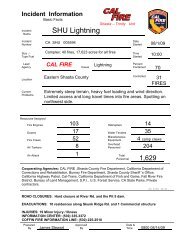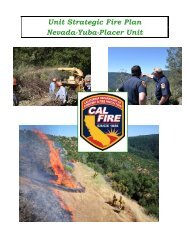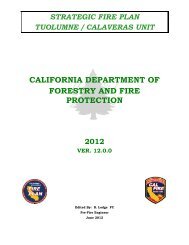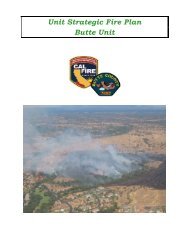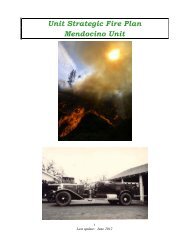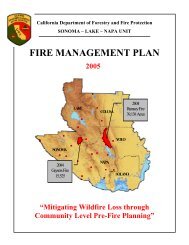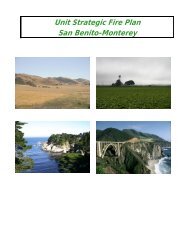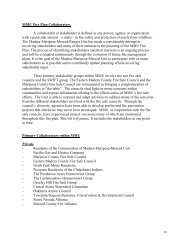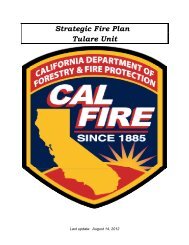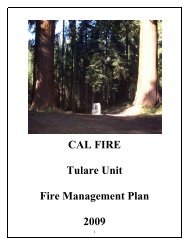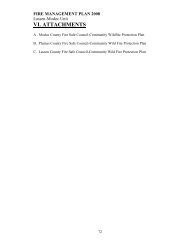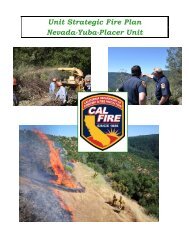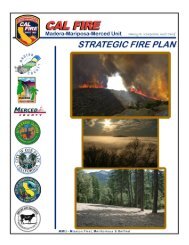Strategic Fire Plan San Diego Unit (MVU) - Board of Forestry and ...
Strategic Fire Plan San Diego Unit (MVU) - Board of Forestry and ...
Strategic Fire Plan San Diego Unit (MVU) - Board of Forestry and ...
You also want an ePaper? Increase the reach of your titles
YUMPU automatically turns print PDFs into web optimized ePapers that Google loves.
approximately 570 square miles, <strong>and</strong> nearly 363,000 acres <strong>of</strong> State Responsibility Area as well as Direct<br />
Protection responsibility for BLM l<strong>and</strong>s, <strong>and</strong> a small portion <strong>of</strong> Forest l<strong>and</strong>s with-in the identified area.<br />
Numerous county highways <strong>and</strong> 1 State highway traverse the battalion, serving the rural communities<br />
identified above as well as the additional communities <strong>of</strong> Dulzura, Barrett Junction, <strong>and</strong> Tecate.<br />
Battalion 3 works with a number <strong>of</strong> cooperating fire agencies on virtually all fire incidents with-in the<br />
battalion including; <strong>San</strong> <strong>Diego</strong> Rural <strong>Fire</strong> Protection District, U.S. Forest Service, Bureau <strong>of</strong> L<strong>and</strong><br />
Management, <strong>and</strong> the U.S. Fish <strong>and</strong> Wildlife Service. <strong>San</strong> <strong>Diego</strong> Rural <strong>Fire</strong> Protection District comprises<br />
the only cooperative (Schedule A) agreement with-in the Battalion. Data on this cooperative agreement is<br />
listed below:<br />
The <strong>San</strong> <strong>Diego</strong> Rural <strong>Fire</strong> Protection District (SDRFPD) is located in the southern portion<br />
<strong>of</strong> <strong>San</strong> <strong>Diego</strong> County, west from Otay Mesa, east to Jacumba, south to the border <strong>of</strong><br />
Mexico, <strong>and</strong> as far north as Ramona . It covers an area <strong>of</strong> 720 square miles <strong>and</strong> serves<br />
an estimated population <strong>of</strong> 42,000 with approximately 9,000 structures. Of this<br />
geographic boundary area, it is mixed with Local Responsibility Area, State Responsibility<br />
Area, <strong>and</strong> <strong>Unit</strong>ed States Forest l<strong>and</strong>s. The vast majority <strong>of</strong> the communities served are<br />
located in the wildl<strong>and</strong> fire hazard zone. The SDRFPD provides a full range <strong>of</strong> structural<br />
<strong>and</strong> wildl<strong>and</strong> fire protection, as well as emergency medical care services from Fourteen<br />
District-owned fire stations (Stations 22, 24, 25, 26, 33, 34, 35, 36, 37, 38, 39, 42, 43, <strong>and</strong><br />
45). Our department is a public <strong>Fire</strong> department whose members are a combination <strong>of</strong><br />
paid <strong>and</strong> volunteer. The fire protection problem in the communities SDRFPD serves is<br />
classed rural/suburban. The SDRFPD has an Insurance Services Office (ISO) rating <strong>of</strong> 5<br />
<strong>and</strong> 9.<br />
Fuels with-in battalion 3 is typical Southern California Chaparral species, (predominantly fuel models 3, 4,<br />
<strong>and</strong> 6) which readily lend themselves during seasonal norms to rapid fire spread <strong>and</strong> development.<br />
Elevations range from 700’ MSL to 2900’ MSL. As such, we experience an active wild l<strong>and</strong> fire season<br />
typically from mid May thru December.<br />
Weather patterns are typical for this latitude with lows during winter months in the 40’s <strong>and</strong> can<br />
experience in the summer months prolonged periods above 100 degrees. Like most <strong>of</strong> Southern<br />
California, the area experiences on-shore winds in the afternoon during most <strong>of</strong> the summer months, <strong>and</strong><br />
monsoonal thunder storm activity is typical during late July thru early September. <strong>San</strong>ta Ana weather<br />
patterns usually develop in early fall.<br />
Battalion 3 has experienced 2 major fires during <strong>San</strong>ta Ana wind events in the previous 8 years. October<br />
24 – 27 2003; “Mine <strong>Fire</strong>” Otay Mountain Wilderness area, over 49,000 acres, <strong>and</strong> October 2007 “Harris<br />
<strong>Fire</strong>”, over 94,000 acres, originating in the community <strong>of</strong> Potrero <strong>and</strong> burning west to the urban<br />
communities <strong>of</strong> Rancho <strong>San</strong> <strong>Diego</strong>, <strong>and</strong> City <strong>of</strong> Chula Vista.<br />
Statistically, Battalion 3 has a significant amount <strong>of</strong> initial attack wild l<strong>and</strong> fire activity as well as the major<br />
fire activity listed above.<br />
Of particular concern are the communities <strong>of</strong> Lawson Valley, <strong>and</strong> Lyons Valley. These communities were<br />
not impacted by the fires identified above. The last recorded fire activity in these communities was the<br />
1970 “Laguna <strong>Fire</strong>”, also a <strong>San</strong>ta Ana wind event catastrophe. Fuel age classes in these communities<br />
are over 40 years with a significant dead to live component in the decadent st<strong>and</strong>s. The issue that has<br />
developed is significant residential development in these areas since the “Laguna <strong>Fire</strong>”. In addition to the<br />
age class <strong>of</strong> the fuel, both communities share a significant problem with access <strong>and</strong> egress in the event <strong>of</strong><br />
a major fire. In the case <strong>of</strong> Lawson Valley, Lawson Valley Rd. is the only means <strong>of</strong> access or egress into<br />
this community, <strong>and</strong> the only means <strong>of</strong> egress travel is to the west. Lawson Valley is essentially a cul-desac<br />
canyon with no eastern access or egress from the valley.<br />
In terms <strong>of</strong> Communities at risk, the following assessment each <strong>of</strong> the communities <strong>of</strong> concern:<br />
LAWSON VALLEY <strong>and</strong> LYONS VALLEY -- Hazard: Extreme. 40 year or older vegetation, remote<br />
limited access<br />
DULZURA -- Hazard: Medium. Burned in 2007 Harris <strong>Fire</strong>. Regular wildl<strong>and</strong> fire history<br />
22



